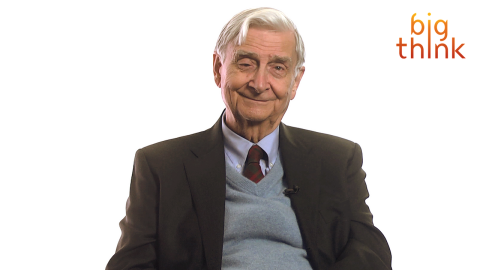E.O. Wilson: E.T. Is Out There and He/She Probably Looks Like This

Biologist Edward O. Wilson, a two-time Pulitzer Prize recipient and the author of the new book The Meaning of Human Existence, discusses extraterrestrial life in today’s featured Big Think video. You can watch the clip below.
Wilson begins by explaining why it’s likely intelligent extraterrestrial life exists somewhere in space. The short answer is that there are hundreds of millions of stars out there which means our planet Earth is but one of hundreds of millions of planets. A large enough sample from this horde of spheres exists in what’s called “the Goldilocks zone,” which is defined as the distance a planet must be from its star so that life-sustaining elements and resources may thrive. Bill Nye (the Science Guy!) discussed the Goldilocks zone here on Big Think two years ago, so we recommend you watch his video (there’s also a transcript at the linked page) for more information on that topic.
Enough planets exist within the many Goldilocks zones throughout the cosmos that sheer probability suggests we’re probably not alone. Of course, it takes more than just standing in the right place for a sophisticated human-like species to develop. Another factor is time:
“In our case we have had half a billion years since life came on the land, to produce a human grade eusocial species. So we can only guess that it’s likely that that has occurred in some of them.”
Wilson uses the word “eusociality” and its derivatives a few times during his interview. Eusociality (that links to a Wikipedia article, albeit a well-sourced one) is “the highest level of organization of animal sociality.” While the term is often used to describe ants and other insects, Wilson — who specializes in the study of ants — is a major proponent of the idea of human beings as a eusocial species. He draws this from how we divide labor, how our generations overlap, and that we as a society handle the raising and rearing of children.
Wilson explains that there are certain prerequisites necessary for the development of a “human grade eusocial species.” The first of these is land, as he sees no possibility for an aquatic species to reach eusociality. The reason for this is tied into the second prerequisite: fire.
“You just have to have, in order to build tools beyond chipping some rock or stone away or maybe crude binding or fashioning materials together, you don’t have any way to create more advanced technology without concentrated power source that you can transport from one place to another.”
Based on our understanding of the record of multiple origins of animal lines on earth, Wilson paints a picture of what he think “E.T.” would look like:
“E.T. has got a head. And the head’s upfront and the head contains a central organizing center for all of the senses that are spread out through the body.
E.T. has got a small number of limbs, multiple, maybe six, who knows maybe eight like a spider, but not that many, relatively few. And ET has on these limbs fingers or tentacles, something with strength and flexibility that are free. That was the prerequisite that we had when we stepped out of the trees, our ancestors did five million years or so ago. The earliest known Australopithecus prehumen already was walking on hind legs. That was just an adaptation it had. And one of the consequences of freeing the front legs is that now you have organs that can be modified to manipulate… You have to have soft pulpy fingertips… That’s a primate trait, soft pulpy fingertips. Because you need those to manipulate finely, in our ancestors’ case and all the primates that are arboreal and so on, you need to be able to manipulate bits of food like plucking free a piece of fruit, plucking seeds out of a fruit, taking a flower and opening it and eating it and so on. So that’s another trait of ET.”
That’s a lot to process but you can see the game Wilson is playing here. Based on what we know about the events and consequences of human development, we can posit the necessary prerequisites for a species like ours to exist elsewhere in the galaxy. Wilson goes on to admonish Hollywood screenwriters who puts claws on their humanoid alien species. Claws are for carnivores; our alien friends would need to be omnivores. He also believes that an Earth-like planet elsewhere in the universe would not produce an intelligent species bigger than a primate. He calls it a Goldilocks zone rule for size.
Aside from physical characteristics, a human-like species would also need to develop certain moral instincts.
“That is they will be able to be generous, to at least some extent, caring and altruistic, not just to individuals of their own species but to other species. And there’s a reason I say that and that is because almost certainly all of the eusocial creatures that produce advanced societies did so through group selection. Group versus group. When you have groups competing with groups and helping drive social instincts by this Darwinian superiority of cooperation within the group, then you have the capacity for a moral system within a group and then eventually between groups under certain circumstances.“
Wilson ends the interview with a brief description of the nature of selfishness versus altruism in a eusocial species. Within a group, the selfish tend to prevail. Between groups, the altruistic sects overcome the selfish sects.
“So you get a kind of balance always in human evolution between a tendency to be increasingly altruistic and cooperative, balanced to some extent by a tendency of individuals in these groups to behave in a selfish manner with respect to others. And that’s balance in human beings and it’s unstable.”
That instability is important. It’s what develops what some think of as the human condition. All these conflicts promote creativity, art, and competition. And as Wilson explains, those three elements drive a lot of the salience of the evolution of civilization.





